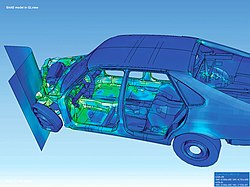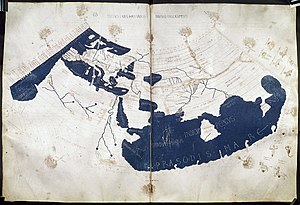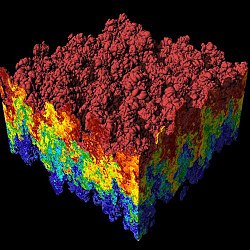- See also Information graphics

Visualization is any technique for creating images, diagrams, or animations to communicate a message. Visualization through visual imagery has been an effective way to communicate both abstract and concrete ideas since the dawn of man. Examples from history include cave paintings, Egyptian hieroglyphs, Greek geometry, and Leonardo da Vinci's revolutionary methods of technical drawing for engineering and scientific purposes.
Visualization today has ever-expanding applications in science, education, engineering (e.g. product visualization), interactive multimedia, medicine, etc. Typical of a visualization application is the field of computer graphics. The invention of computer graphics may be the most important development in visualization since the invention of central perspective in the Renaissance period. The development of animation also helped advance visualization.
Contents[hide]
|
[edit] Overview


The use of visualization to present information is not a new phenomenon. It has been used in maps, scientific drawings, and data plots for over a thousand years. Examples from cartography include Ptolemy's Geographia (2nd Century AD), a map of China (1137 AD), and Minard's map (1861) of Napoleon's invasion of Russia half a century earlier. Most of the concepts learned in devising these images carry over in a straight forward manner to computer visualization. Edward Tufte has written two critically acclaimed books that explain many of these principles.
Computer graphics has from its beginning been used to study scientific problems. However, in its early days the lack of graphics power often limited its usefulness. The recent emphasis on visualization started in 1987 with the special issue of Computer Graphics on Visualization in Scientific Computing. Since then there have been several conferences and workshops, co-sponsored by the IEEE Computer Society and ACM SIGGRAPH, devoted to the general topic, and special areas in the field, for example volume visualization.
Most people are familiar with the digital animations produced to present meteorological data during weather reports on television, though few can distinguish between those models of reality and the satellite photos that are also shown on such programs. TV also offers scientific visualizations when it shows computer drawn and animated reconstructions of road or airplane accidents. Some of the most popular examples of scientific visualizations are computer-generated images that show real spacecraft in action, out in the void far beyond Earth, or on other planets. Dynamic forms of visualization, such as educational animation or timelines, have the potential to enhance learning about systems that change over time.
Apart from the distinction between interactive visualizations and animation, the most useful categorization is probably between abstract and model-based scientific visualizations. The abstract visualizations show completely conceptual constructs in 2D or 3D. These generated shapes are completely arbitrary. The model-based visualizations either place overlays of data on real or digitally constructed images of reality, or they make a digital construction of a real object directly from the scientific data.
Scientific visualization is usually done with specialized software, though there are a few exceptions, noted below. Some of these specialized programs have been released as Open source software, having very often its origins in universities, within an academic environment where sharing software tools and giving access to the source code is common. There are also many proprietary software packages of scientific visualization tools.
Models and frameworks for building visualizations include the data flow models popularized by systems such as AVS, IRIS Explorer, and VTK toolkit, and data state models in spreadsheet systems such as the Spreadsheet for Visualization and Spreadsheet for Images.
[edit] Applications of visualization

As a subject in computer science, data visualization or scientific visualization is the use of interactive, sensory representations, typically visual, of abstract data to reinforce cognition, hypothesis building and reasoning.
[edit] Scientific visualization
Scientific visualization is the transformation, selection or representation of data from simulations or experiments, with an implicit or explicit geometric structure, to allow the exploration, analysis and understanding of the data. It's a very important part of visualization and maybe the first one, as the visualization of experiments and phenomena is as old as Science itself. Traditional areas of Scientific Visualization are Flow Visualization, medical visualization, astrophysical visualization and chemical visualization. There are several different techniques to visualize scientific data, with isosurface reconstruction and direct volume rendering being the more common.
[edit] Educational visualization
Educational visualization is using a simulation normally created on a computer to create an image of something so it can be taught about. This is very useful when teaching about a topic which is difficult to otherwise see, for example, atomic structure, because atoms are far too small to be studied easily without expensive and difficult to use scientific equipment. It can also be used to view past events, such as looking at dinosaurs, or looking at things that are difficult or fragile to look at in reality like the human skeleton, without causing physical or mental harm to a subjective volunteer or cadaver.
[edit] Information visualization
Information visualization concentrates on the use of computer-supported tools to explore large amount of abstract data. The term "information visualization" was originally coined by the User Interface Research Group at Xerox PARC and included Dr. Jock Mackinlay. Practical application of information visualization in computer programs involves selecting, transforming and representing abstract data in a form that facilitates human interaction for exploration and understanding. Important aspects of information visualization are dynamics of visual representation and the interactivity. Strong techniques enable the user to modify the visualization in real-time, thus affording unparalleled perception of patterns and structural relations in the abstract data in question.
[edit] Knowledge visualization
The use of visual representations to transfer knowledge between at least two persons aims to improve the transfer of knowledge by using computer and non-computer based visualization methods complementarily.[1] Examples of such visual formats are sketches, diagrams, images, objects, interactive visualizations, information visualization applications and imaginary visualizations as in stories. While information visualization concentrates on the use of computer-supported tools to derive new insights, knowledge visualization focuses on transferring insights and creating new knowledge in groups. Beyond the mere transfer of facts, knowledge visualization aims to further transfer insights, experiences, attitudes, values, expectations, perspectives, opinions, and predictions by using various complementary visualizations.
[edit] Product Visualization
Product Visualization involves visualization software technology for the viewing and manipulation of 3D models, technical drawing and other related documentation of manufactured components and large assemblies of products. It is a key part of Product Lifecycle Management. Product visualization software typically provides high levels of photorealism so that a product can be viewed before it is actually manufactured. This supports functions ranging from design and styling to sales and marketing. Technical visualization is an important aspect of product development. Originally technical drawings were made by hand, but with the rise of advanced computer graphics the drawing board has been replaced by computer-aided design (CAD). CAD-drawings and models have several advantages over hand-made drawings such as the possibility of 3-D modeling, rapid prototyping and simulation.
[edit] Visual communication
Visual communication is the communication of ideas through the visual display of information. Primarily associated with two dimensional images, it includes: alphanumerics, art, signs, and electronic resources. Recent research in the field has focused on web design and graphically oriented usability.
[edit] Visual analytics
Visual analytics focuses on human interaction with visualization systems as part of a larger process of data analysis. Visual analytics has been defined as "the science of analytical reasoning supported by the interactive visual interface" [2].
Its focus is on human information discourse (interaction) within massive, dynamically changing information spaces. Visual analytics research concentrates on support for perceptual and cognitive operations that enable users to detect the expected and discover the unexpected in complex information space.
Technologies resulting from visual analytics find their application in almost all fields, but are being driven by critical needs (and funding) in biology and national security.
[edit] Visualization techniques
The following are examples of some common visualization techniques:
- Constructing isosurfaces
- direct volume rendering
- Streamlines, streaklines, and pathlines
- table, matrix
- charts (pie chart, bar chart, histogram, function graph, scatter plot, etc.)
- graphs (tree diagram, network diagram, flowchart, existential graph, etc.)
- Maps
- parallel coordinates - a visualization technique aimed at multidimensional data
- treemap - a visualization technique aimed at hierarchical data
- Venn diagram
- Timeline
- Euler diagram
- Chernoff face
- Hyperbolic trees
- brushing and linking
- Cluster diagram or dendrogram
- Ordinogram
[edit] Related research areas
- Statistics, statistical package, multivariate statistics
- Forecasting, technical analysis
- Data Mining, also known as knowledge-discovery in databases (KDD)
- GeoVisualization, short for Geographic Visualization
- Graph Drawing
- Scientific modeling
- Cave Automatic Virtual Environment
- Morphological Modeling
- Information graphics
- Knowledge management
- Knowledge transfer
- Concept maps
- Morphological analysis
- Formal concept analysis
- Conceptual graphs
[edit] See also
- Information graphics
- The Information visualization reference model for construction of Information Visualization systems. Similar to the 'Model view controller' software engineering architectural pattern.
- Music visualization
- Statistical graphics
- Configurator visualization
- Graph drawing
- Graphic design
- Edward Tufte
- Human-computer interaction
- Rendering (computer graphics)
- Illustration
- Imaging
- New Epoch Notation Painting
- Representation (arts)
- Representation (psychology)
- Many Eyes Public, web-based visualizations
- Prefuse Java Toolkit for Interactive Information Visualization
- Starlight Info Vis System, R&D 100 winner
- VisIt, R&D 100 winner
- VisTrails
- ParaView
- Tulip C++/Qt framework for navigation, graph drawing, clustering and edition of huge graphs.
[edit] References
- ^ (Burkhard and Meier, 2004),
- ^ (Thomas, JJ and Cook, KA, 2005)
http://nvac.pnl.gov/agenda.stm#book
| | This article is missing citations or needs footnotes. Please help add inline citations to guard against copyright violations and factual inaccuracies. (January 2008) |
[edit] Further reading
- Books
- Visualization Handbook (Hardcover) by Charles D. Hansen, Chris Johnson, Academic Press (June, 2004).
- The Visualization Toolkit, Third Edition (Paperback) by Will Schroeder, Ken Martin, Bill Lorensen (August 2004).
- Thomas, James J, and Cook, Kristin A, Ed. (2005), Illuminating the Path: The Research and Development Agenda for Visual Analytics, Los Alamitos, CA.: IEEE Computer Society, http://nvac.pnl.gov/agenda.stm
- Globus, Al. Eric Raible. "Fourteen Ways to Say Nothing With Scientific Visualization". Computer. July 1994. pp. 86-88
- Kravetz, Stephen A. and David Womble. ed. Introduction to Bioinformatics. Totowa, N.J. Humana Press, 2003.
- Nielson, Gregory M. ed. Computer. Vol. 22, No. 8, Aug 1989. Special issue on scientific visualization.
- Edward R. Tufte (1992). The Visual Display of Quantitative Information
- Edward R. Tufte (1990). Envisioning Information.
- Edward R. Tufte (1997). Visual Explanations: Images and Quantities, Evidence and Narrative.
- Wong, Pak Chung. R. Daniel Bergeron. "30 years of Multidimensional Multivariate Visualization". Scientific Visualization Overviews Methodologies and Techniques. IEEE Computer Society Press, 1997.
- Marty R. Applied Security Visualization. Pearson Education, 2008.
- Information Visualization Papers
- Bederson, Benjamin B., Shneiderman, Ben. The Craft of Information Visualization: Readings and Reflections, Morgan Kaufmann, 2003, ISBN 1-55860-915-6.
- Mackinlay, Jock D. (1999). Readings in information visualization: using vision to think. Card, S. K., Ben Shneiderman (eds.). Morgan Kaufmann Publishers Inc. pp. 686. ISBN 1-55860-533-9.
- Cleveland, William S. (1993). Visualizing Data.
- Cleveland, William S. (1994). The Elements of Graphing Data.
- Schirra, Joerg R.J. (2005). Foundation of Computational Visualistics, Wiesbaden: DUV ISBN 3-8350-6015-5.
- Spence, Robert Information Visualization: Design for Interaction (2nd Edition), Prentice Hall, 2007, ISBN 0-132-06550-9.
- Colin Ware (2000). Information Visualization: Perception for design.
- Andrew Vande Moere (2008). Form Follows Data.
- Wilkinson, Leland. "The Grammar of Graphics", Springer ISBN 0-387-24544-8 [1]
No comments:
Post a Comment